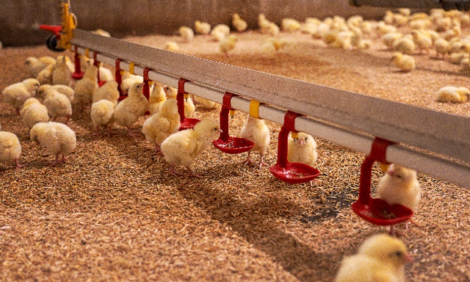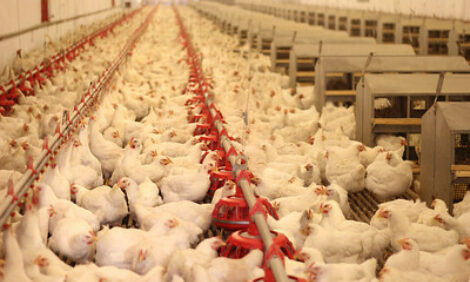



Genetics, Stocking Density Affect Broiler Leg Development
Two scientific papers published recently investigated factors affecting broiler leg development and strength. Researchers in the US found that broilers from a typical fast growing line had larger and stronger bones than slow-growing ones at the same age but that tibia density and bone ash percentage of the slow-growing birds were higher per unit of final bodyweight. In Belgium, scientists observed that increasing stocking density had adverse effects on some aspects of bone quality but they were unable to conclude whether fluctuating asymmetry impacted bird welfare.Effects of Growth Rate on Leg Morphology and Tibia Breaking Strength, Mineral Density, Mineral Content and Bone Ash in Broilers
Fast-growing broilers are especially susceptible to bone abnormalities, causing major problems for broiler producers, report M.Y. Shim1 of the University of Georgia in the US and co-authors from USDA-ARS in Beltsville and the University of Arkansas in their paper in a recent issue of Poultry Science. The cortical bones of fast-growing broilers are highly porous, which may lead to leg deformities, they explain.
Leg problems were investigated in six-week-old Arkansas random-bred broilers. Body weight was measured at hatch and at six weeks. There were eight different settings of approximately 450 eggs each. Two subpopulations, slow-growing (SG; bottom quarter, n=511) and fast-growing (FG; top quarter, n=545), were created from a random-bred population based on their growth rate from hatch until six weeks of age.
At six weeks of age, the broilers were processed and chilled at 4°C overnight before deboning.
Shank (78.27±8.06g), drum stick (190.92±16.91g) and thigh weights (233.88±22.66g) of FG broilers were higher than those of SG broilers (54.39±6.86g, 135.39±15.45g and 168.50±21.13g, respectively; P<0.001).
Tibia weights (15.36±2.28g) of FG broilers were also greater than those of SG broilers (11.23±1.81g; P<0.001).
Shank length (81.5±4.71mm) and tibia length (104.34±4.45mm) of FG broilers were longer than those of SG broilers (71.88±4.66mm and 95.98±4.85mm, respectively; P<0.001).
Shank diameter (11.59±1.60mm) and tibia diameter (8.20±0.62mm) of FG broilers were wider than those of SG broilers (9.45±1.74mm, 6.82±0.58mm, respectively; P<0.001).
Tibia breaking strength (28.42±6.37kg) of FG broilers was higher than those of SG broiler tibia (21.81±5.89kg; P<0.001).
Tibia density and bone mineral content (0.13±0.01g per square centimetre and 1.29±0.23g, respectively) of FG broilers were higher than those of SG broiler tibia (0.11±0.01g per square centimetre and 0.79±0.1g; P<0.001).
Tibia percentage of ash content (39.76±2.81) of FG broilers was lower than that of SG broilers (39.99±2.67; P = 0.173).
Fast-growing broiler bones were longer, wider, heavier, stronger, more dense and contained more ash than SG ones, concluded Shim and co-authors. After all parameters were calculated per unit of final bodyweight at six weeks of age, tibia density and bone ash percentage of FG broilers were lower than those of SG broilers, however.
Influence of Stocking Density on Broiler Chicken Bone Quality and Fluctuating Asymmetry
Because broiler chickens are juvenile animals undergoing physical development, stocking density during rearing may influence this development. Some of these physical changes may cause welfare problems, for example, decreased bone quality, which may lead to fracture during catching and transport, according to Stephanie Buijs2 of the Institute for Agricultural and Fisheries Research (ILVO) in Melle, Belgium and co-authors there and at the universities of Antwerp and Ghent.
In their recent paper in Poultry Science, they explain that other changes do not influence welfare directly but may be used as indicators of the animal's ability to cope with its environment, such as fluctuating asymmetry.
Their study aimed to evaluate the effects of stocking density on bone quality and fluctuating asymmetry. Birds were stocked at densities of 2.4, 5.8, 8.8, 12.1, 13.6, 15.5, 18.5, and 21.8 birds per square metre from one until 39 days of age.
They found that increased stocking density had a negative effect on some aspects of bone quality (tibia curvature and shear strength). Tibias were shorter at high density, possibly due to increased curvature. Several other bone quality aspects (tibia weight, torsion, and dyschondroplasia, and femur curvature and epiphysis shape) remained unaffected.
Middle-toe length was the only character that showed a significant increase with increasing density when each character was analysed separately. Nevertheless, a composite index of fluctuating asymmetry, which combined data on all 11 measured characters, tended to increase with stocking density.
Such increased fluctuating asymmetry may indicate decreased welfare, according to Buijs and co-authors. However, one of the assumptions of fluctuating asymmetry is that the animal is subjected to the same environmental influences on both sides. This assumption may not be fulfilled when leg deformations occur, as these may lead to asymmetric changes in bone growth by altering the division of force over the two legs.
In addition, leg deformations decrease the accuracy of bone length measurements made in a straight line, the researchers added. This raises some concerns on the applicability of fluctuating asymmetry measurements on broiler chicken legs, especially because stocking density did not affect the asymmetry of the head.
References
1. Shim M.Y., A.B. Karnuah, A.D. Mitchell, N.B. Anthony, G.M. Pesti and S.E. Aggrey. 2012. The effects of growth rate on leg morphology and tibia breaking strength, mineral density, mineral content, and bone ash in broilers. Poult. Sci., 91(8):1790-1795. doi: 10.3382/ps.2011-01968
2. Buijs S., E. Van Poucke, S. Van Dongen, L. Lens, J. Baert and F.A.M. Tuyttens. 2012. The influence of stocking density on broiler chicken bone quality and fluctuating asymmetry. Poult. Sci., 91(8):1759-1767. doi: 10.3382/ps.2011-01859
Further ReadingYou can view the full report by Buijs et al. (fee payable) by clicking here.You can view the full report by Shim et al. (fee payable) by clicking here. |
October 2012








